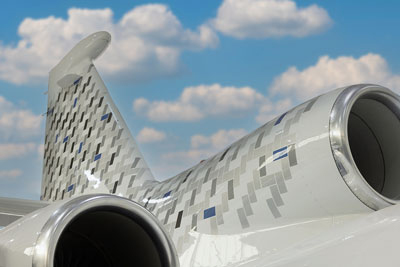
I travel extensively throughout the Great Lakes Region of the United States, visiting Duncan Aviation customers and introducing myself to new prospects. I listen to their needs and answer all their questions. Although they may work for different companies and fly various make/model aircraft, they have the same concerns and questions regarding maintaining aircraft.
When discussing aircraft paint, I can predict their concerns and have prepared a list of questions with answers to respond with the most correct information.
I’m also confident that aircraft operators everywhere are interested in this information.
Here are the answers to the most common aircraft paint questions I get asked when visiting customers:
Question: What is Duncan Aviation’s warranty?
Answer: 3 years / 1500 hours
This is the best aircraft paint warranty in the business aviation industry.
Question: How do you handle corrosion found during aircraft paint projects?

Answer: Duncan Aviation has an in-house airframe structures team capable of handling all corrosion issues. We work directly with the OEM engineers and our internal engineering certification team to create a plan for the most severe cases.
Question: How many aircraft does Duncan Aviation paint every year?
Answer: Duncan Aviation is one of the busiest paint providers in the business aircraft refurbishment industry. We paint over 250 aircraft annually at our state-of-the-art facilities in Battle Creek, Michigan; Lincoln, Nebraska; and Provo, Utah.
Question: Are there any hidden extras your bids do not include?
Answer: Duncan Aviation paint quotes are all-inclusive, capturing miscellaneous charges in the bottom line, including freight, consumables, and hazmat fees. All customer custom and creative paint schemes are encouraged, discussed, and agreed to before acceptance of the proposal.
Question: How long can I expect my aircraft to be down for paint?
Answer: Duncan Aviation’s standard downtime for a complete strip and repaint is 22 calendar days, excluding any major holidays should a paint slot fall into one. Long-range aircraft or custom paint schemes may result in extended turntimes.
We work with every customer to create a plan to have their aircraft returned to them in the required time. Contact us for details specific to your needs.
Question: Can I get help creating the design?
Answer: Yes. All aircraft paint customers are assigned a dedicated Duncan Aviation aircraft designer. Customer-designer collaboration is highly encouraged.
Question: Can I see some of your past aircraft paint projects?
Answer: Most assuredly. You can view many of our completed aircraft paint projects on the Duncan Aviation Paint Galleries. Aircraft paint customer testimonials are available upon request as well.
Question: What paint brand and type does Duncan Aviation use?
Answer: While Duncan Aviation is willing to accommodate most customers’ desired aircraft paint type, at present, we find our best results are obtained using PPG or AkzoNobel High Solid Polyurethane for the base coat with Axalta Polyurethane for accent colors and stripes.
Duncan Aviation has three business aircraft paint facilities in Battle Creek, Michigan; Lincoln, Nebraska; and Provo, Utah. All have the latest down-draft airflow technology, including automatic monitoring and alarms, to provide the best paint environment possible for aircraft. Our paint hangars are designed to accommodate multiple aircraft at once, utilizing a two-zone airflow system. With this design, Duncan Aviation paint teams can perform stripping, sanding, painting, and detail work on multiple aircraft simultaneously.
December 2025
December 2025
November 2025
October 2025
September 2025